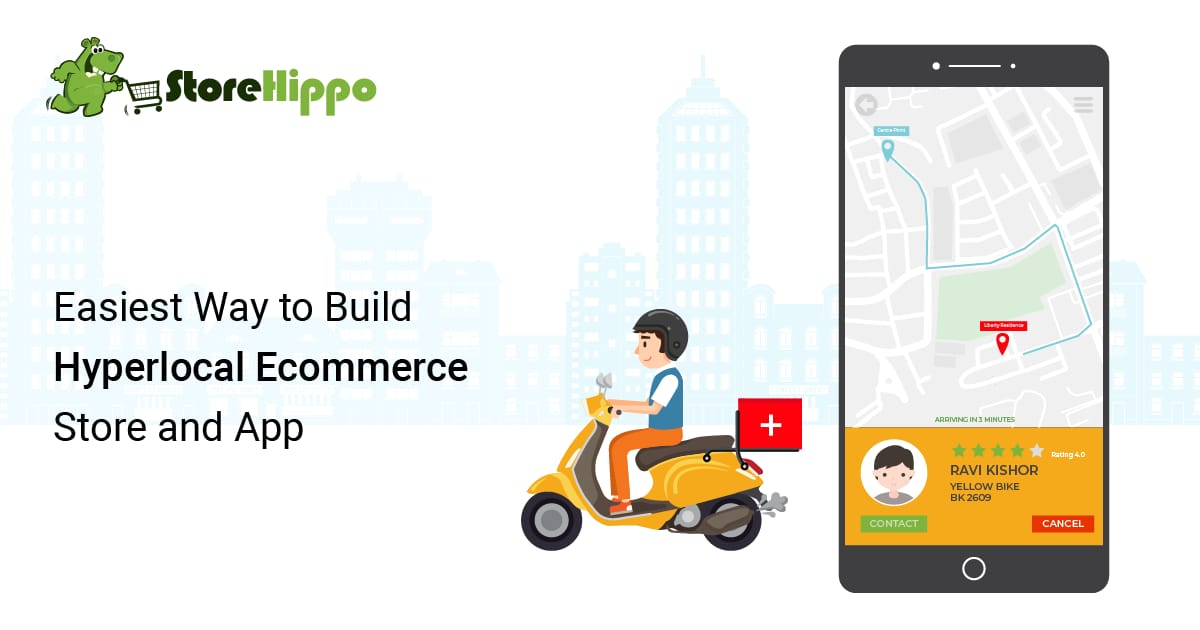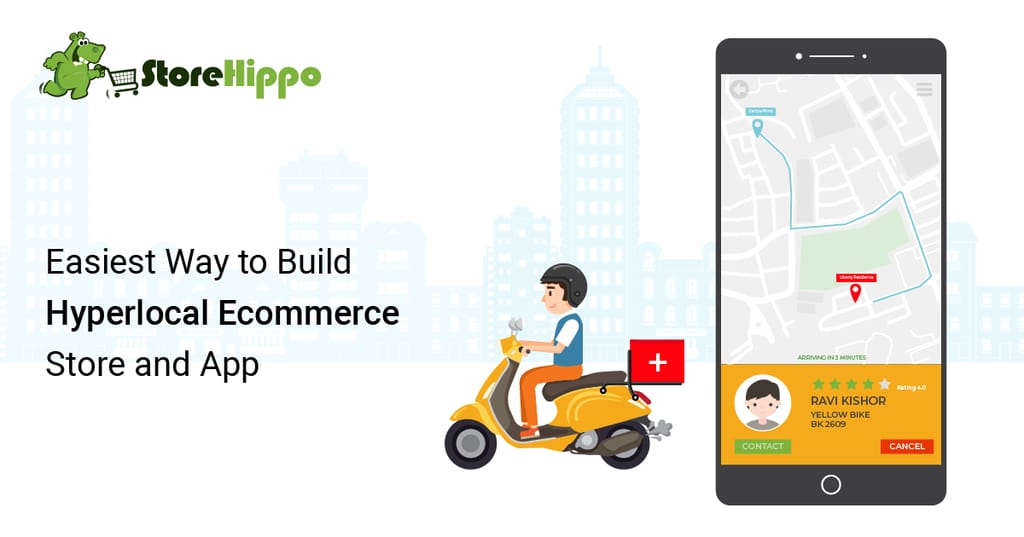Thinking of going hyperlocal? You can’t be having a better opportunity to launch your hyperlocal ecommerce store than the current market scenario.
With the government now allowing the supplies of even non-essential items in different zones, you sure stand a chance to grab this opportunity and start selling online!
BigBasket, Grofers, Amazon and Flipkart – all these major brands have already turned to localized services to attract customers and supply them daily essentials. Most of them have joined hands to tide over supply-chain challenges with companies like Uber and Rapido amid the lockdown. Needless to say, more players like JioMart are now jumping into the bandwagon.
But with all these big players trying to get opportunistic and boosting sales with hyperlocal ecommerce stores, it does not mean that small business owners or start-ups cannot flourish.
After all, you only need to take care of customers near you! Isn’t that what hyperlocal stands for?
With a good website in place and reliable vendors, you are on your way to creating a trusted name amongst your customers.
Table of Contents
- What are the key benefits of a geo-location-based system?
- How to build Hyperlocal ecommerce store and app
- What are you waiting for?
What are the key benefits of a geo-location-based system?
A geolocation based business offers great benefits to the sellers as well as customers - from the convenience of proximity to closing the sales in as less as 24 hours.
Say for instance, you want to buy groceries online. A nationwide grocery retailer may expect you to order today so that they can deliver tomorrow. But a hyperlocal ecommerce grocery merchant would guarantee that you get the supplies within a day’s time or may be even less than that.
Thus a local-based business can deliver food, medicine, groceries, customer goods, and services to customers in the shortest time duration.
A unique characteristic of this is that the whole supply chain exists entirely near to your customers and the vendors. Thus shipping becomes a less cumbersome affair. Moreover, customers can also opt for in-store pickups as and when they please, making your task further simple.
How to build Hyperlocal ecommerce store and app
1. Choose a reliable ecommerce platform and create your website
This is literally the starting point of your online journey - choosing the right platform to build your store.
A Saas-based ecommerce platform is a good choice rather than other market options. This kind of platform reduces your go-to market time considerably and is comparatively very safe in terms of handling your data.
Your choice of platform should also depend upon the platform’s capability to;
- Handle multiple vendors and sub stores
- Track customer geolocation for the promptness of delivery
- Offer a gamut of marketing tools to target customers
Since all these aspects are very important when you are creating a hyperlocal ecommerce store, double-checking them with the solution provider will help you in the long run.
StoreHippo ecommerce platform offers an end-to-end solution to create your geo-location based store. With inherent features such as those mentioned above, it is an all in one solution for all your needs.
2. Develop a mobile app
With a large number of customers browsing your products from their cell phones, you can’t ignore the necessity of a mobile ecommerce store. Can you?
The mobile-first technology helps you create an online store that works seamlessly on any screen size. It is designed for the mobile screen and then adapted to larger screens giving it an advantage across devices.
And that’s not it! Having your website optimised for mobile will fetch you higher rankings in Google’s search pages. So chances are that when customers look for products online along with their location, Google might place your mobile ecommerce store above others and help your customers connect to you.
StoreHippo platform is built with mobile-first technology and thus you do not need to duplicate your website into a mobile version. You can also have Android and iOS apps to help customers access your website on the go.
3. Invite vendors and organise them with multivendor support
Once you have created a geo-location based online store and mobile ecommerce app, then you are ready to on board your sellers.
Finding vendors for your hyperlocal ecosystem is not a very difficult task since most of the sellers might be in your vicinity.
You can simply make a list of different sellers within your category and approach them locally to encourage them to register on your website.
However, managing your vendors could be a challenging task if you do not have a proper support system at the backend. With StoreHipp’s multi-vendor feature, you can onboard vendors and partners and have complete control over their products and inventory while allowing them the freedom to upload new products or manage their shipping. This freedom enables vendors to better manage their businesses on your hyperlocal ecommerce store.
4. Create dealer/ retailer sub stores for direct delivery
Nowadays, amid the lockdown, supply chains have got disrupted. This has increased the gap between consumers' needs and merchant deliveries. Customers have to wait for a longer duration to receive their products and merchants have to be on their toes to cope up with logistics issues.
This problem can be easily tackled by setting up multiple stores based on categorisation of products or customer geolocation. By creating a chain of sub stores and managing them centrally, you can;
- Reach out to more customers in different locations
- Enable direct and quick delivery
So how can you make this possible? Well, by inviting vendors onboard, you have already created a multi-vendor store. Now, with StoreHippo’s multi-store feature you can create sub stores and list products of merchants who can deliver fastest in a particular location. As the owner, you can manage all these stores from a single dashboard at the backend. You can also tweak the stores as per locally preferred languages or by introducing discount packages that might interest your customers.
5. Integrate with payment gateway companies
The biggest purpose of a hyperlocal ecommerce store is to provide maximum convenience to customers. This could be in terms of;
- Faster delivery
- Custom orders
- Payment options
Since different customers would choose to pay differently, you might need to provide various options including e-wallets, card transactions or COD support.
However, nowadays most customers would prefer pre-paid orders, following social distancing norms. This would require you to integrate your store with different payment gateway companies.
StoreHippo integrates your website and mobile ecommerce store with third-party providers such as multiple payment gateways companies. This assures your customers that you are a trusted brand.
6. Seek local shipping support
Shipping products faster than your competitor will keep you ahead in the hyperlocal system. To strengthen your shipping strategy you can;
- automate processes such as uploading of product orders and labeling
- Employ professional fleet to pick-up products from sellers and deliver to customers
StoreHippo offers it’s in-built automated shipping tools to help you with a seamless shipping process. For your hyperlocal ecommerce store, you can further explore the discounted shipping feature to attract customers within a certain radius, in a particular geographical location and so on.
What are you waiting for?
For an instance, you might think that the world has paused amid the lockdown. But in reality, it has moved on.
On one hand, various brands have already explored the hyperlocal business model and are thriving. On the other hand, customers are slowly slipping into the habit of shopping through hyperlocal and mobile ecommerce stores.
So what are you waiting for? Explore StoreHippo’s range of features with a 14-day free trial store and get going. Drop us a line below to get started!





















Leave a Reply